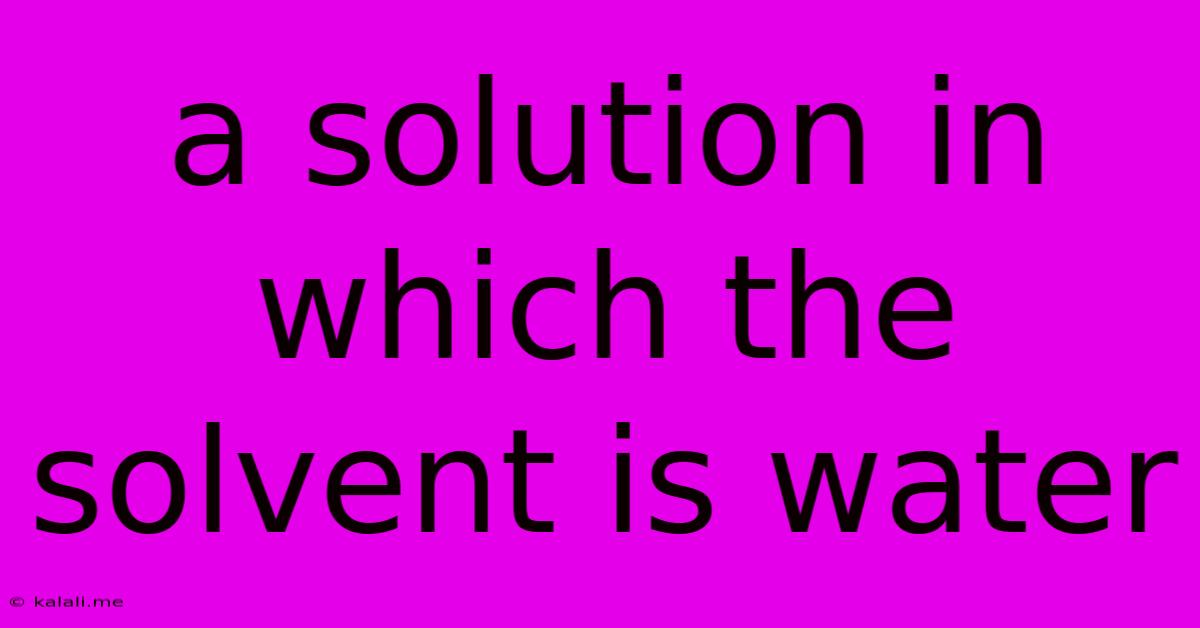A Solution In Which The Solvent Is Water
Kalali
Jun 15, 2025 · 3 min read

Table of Contents
Aqueous Solutions: A Deep Dive into Water as a Solvent
Aqueous solutions are everywhere. From the ocean's vast expanse to the cellular processes within our bodies, water's unique properties make it the most prevalent and versatile solvent on Earth. This article explores the characteristics of aqueous solutions, focusing on why water is such an effective solvent and the implications of its solvency power. Understanding aqueous solutions is crucial in various fields, including chemistry, biology, and environmental science. This detailed examination will cover the fundamental principles, practical applications, and environmental considerations related to aqueous solutions.
What Makes Water Such a Powerful Solvent?
Water's exceptional solvency stems from its polarity and hydrogen bonding. Its molecular structure, with a slightly positive hydrogen end and a slightly negative oxygen end, creates a dipole moment. This polarity allows water molecules to interact strongly with other polar molecules and ions, effectively surrounding and dissolving them. This process is known as hydration, where water molecules form hydration shells around dissolved ions or polar molecules.
The hydrogen bonds between water molecules further enhance its solvency. These relatively strong bonds create a cohesive network that can effectively break apart ionic compounds and polar molecules. This cohesive network also contributes to water's high surface tension and boiling point.
Types of Aqueous Solutions and Their Properties
Aqueous solutions can be categorized based on the nature of the dissolved substance:
-
Ionic Solutions: These are formed when ionic compounds (like salts) dissolve in water, dissociating into their constituent ions. Examples include saltwater (NaCl in water) and solutions of various metal salts. These solutions conduct electricity due to the presence of mobile ions. Conductivity is directly related to the concentration of ions; the higher the concentration, the higher the conductivity. This principle is used in many applications, including electrochemical processes.
-
Molecular Solutions: These solutions are formed when polar molecules dissolve in water. Examples include sugar dissolved in water and solutions of many alcohols. These solutions generally do not conduct electricity as effectively as ionic solutions, as they don't contain freely moving ions.
-
Gaseous Solutions: Gases can also dissolve in water to form aqueous solutions. The solubility of a gas depends on factors such as temperature and pressure. For instance, carbon dioxide dissolved in water forms carbonic acid, which contributes to the acidity of rainwater. Understanding gas solubility in water is important in areas such as oceanography and environmental studies.
Applications of Aqueous Solutions
Aqueous solutions are fundamental to countless processes and applications:
-
Biological Systems: Water is the primary solvent in all living organisms, facilitating biochemical reactions and transporting nutrients and waste products. Understanding the properties of aqueous solutions within cells is essential for comprehending biological processes.
-
Industrial Processes: Many industrial processes rely heavily on aqueous solutions, including chemical synthesis, cleaning, and processing materials. Aqueous solutions are often preferred due to their relative safety and ease of handling compared to other solvents.
-
Pharmaceutical Applications: Many drugs and medications are administered in aqueous solutions, allowing for easier absorption and distribution within the body.
-
Environmental Science: The study of aqueous solutions is critical in understanding environmental processes, such as water pollution, nutrient cycling, and the transport of pollutants in water bodies.
Conclusion
Water's unique properties as a solvent are vital to countless natural and industrial processes. The study of aqueous solutions is a cornerstone of many scientific disciplines, offering insights into the behaviour of matter at a molecular level and providing the foundation for numerous applications across various fields. From understanding the intricate chemistry of life to addressing pressing environmental challenges, the exploration of aqueous solutions continues to be a rich and rewarding area of scientific inquiry.
Latest Posts
Latest Posts
-
Which Range Of Mountains Separates France From Spain
Jun 15, 2025
-
A Similarity Between E Commerce And Traditional Commerce Is That Both
Jun 15, 2025
-
What Is The Prime Factorization Of 102
Jun 15, 2025
-
Convert Mole Fraction To Mass Fraction
Jun 15, 2025
-
Which Of The Following Contains The Highest Number Of Atoms
Jun 15, 2025
Related Post
Thank you for visiting our website which covers about A Solution In Which The Solvent Is Water . We hope the information provided has been useful to you. Feel free to contact us if you have any questions or need further assistance. See you next time and don't miss to bookmark.